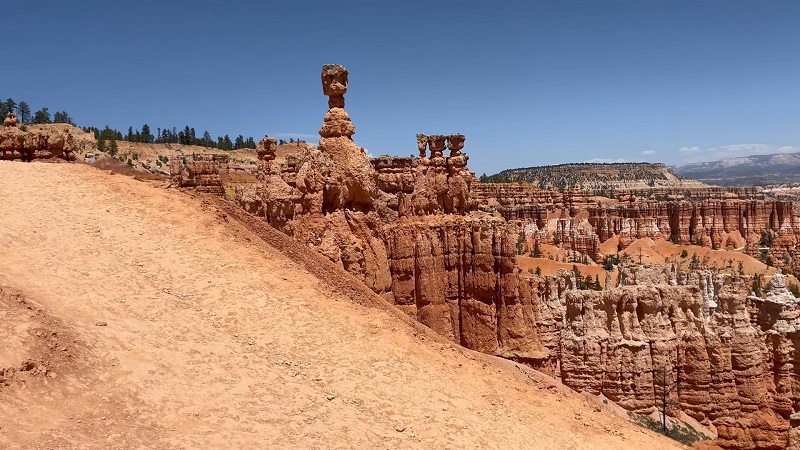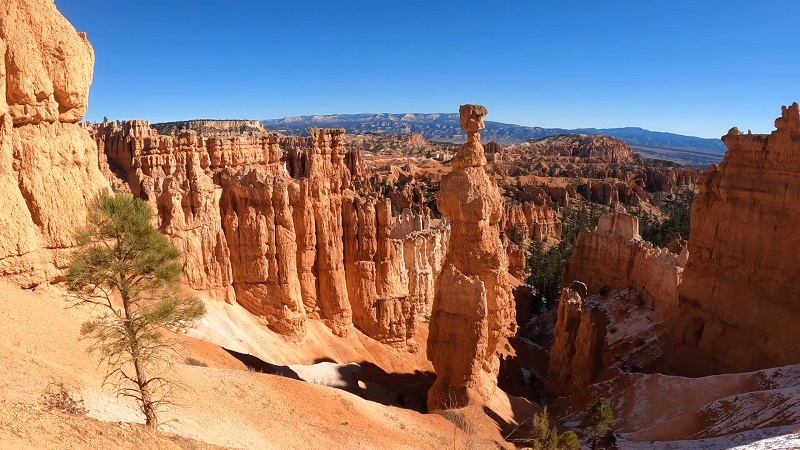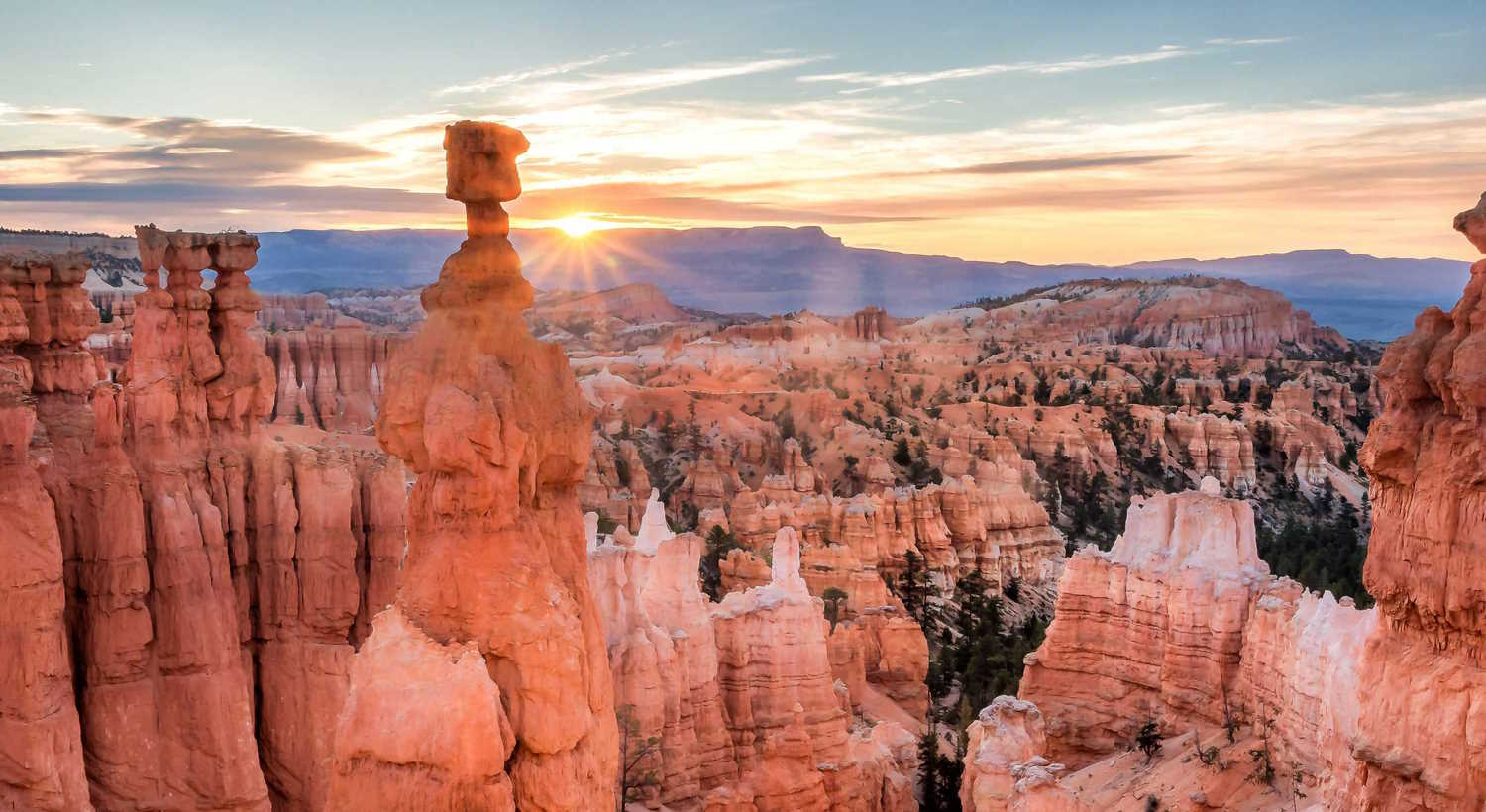Towering above the dusty trails of Bryce Canyon National Park, Thor’s Hammer is one of the most recognizable rock formations in the American Southwest. This distinct hoodoo, shaped by centuries of erosion, draws visitors from around the world who come to witness its gravity-defying structure and dramatic presence within the Bryce Amphitheater.
Positioned just off the popular Navajo Loop Trail and visible from Sunset Point, Thor’s Hammer is more than a geological curiosity—it’s a highlight for hikers, photographers, and anyone interested in the surreal natural beauty of southern Utah.
This guide covers everything you need to know before visiting: how to get there, when to go, what to expect on the trail, and why this particular hoodoo is worth your attention.
Chiseled by Time: What Makes Thor’s Hammer So Iconic

Located in the heart of Bryce Canyon National Park, Thor’s Hammer is not just a hoodoo—it’s a visual landmark that defines the landscape. Its unusual shape—a massive sandstone block teetering atop a narrow pedestal—captures the imagination of hikers, photographers, and geology buffs alike.
The formation gets its name from its resemblance to the mythological weapon wielded by the Norse god Thor. While thousands of hoodoos fill the Bryce Amphitheater, Thor’s Hammer stands out due to its symmetry, color contrast, and prominence on the horizon.
Visiting Thor’s Hammer doesn’t require a long trek, but knowing your entry points and route options makes the experience smoother. The best way to reach it is by starting at Sunset Point, one of the main overlooks at Bryce Canyon. From there, two main access options: If you want the kind of view that makes you pause and reach for your camera, this is it. Thor’s Hammer is most striking when seen against the layered backdrops of Bryce—especially in the morning or late afternoon, when the sunlight rakes across the canyon walls. Top viewing points: To truly appreciate Thor’s Hammer, take the descent into Bryce Canyon via the Navajo Loop Trail. It’s the most direct route to see the hoodoo from multiple angles—and it’s one of the park’s most popular hikes for good reason. The trail drops quickly from the rim, offering shifting perspectives of Thor’s Hammer as you move down through tight switchbacks, past towering walls, and into the shadowed amphitheater below. Trail Overview: Optional Extension: Combine with Queen’s Garden Trail for a longer scenic loop (2.9 miles total). Thor’s Hammer is a classroom in natural erosion. Hoodoos like this one are created over millions of years through the combined forces of frost wedging, rain erosion, and the unique properties of the sedimentary rock layers that make up Bryce Canyon. Here’s how it happens: Timing your visit can change everything—from the clarity of your photos to the number of people on the trail. Bryce Canyon’s elevation (around 8,000 feet) brings wide variations in temperature and conditions throughout the year.Getting There: Your Path to the Hammer
Distance: ~1.3-mile loop
Trail Type: Loop
Difficulty: Moderate (steep sections, switchbacks)The View That Stops Hikers in Their Tracks

A Descent into Bryce: Hiking the Navajo Loop
Rock vs. Time: The Science Behind the Spectacle
Sun, Shadows, and Storms: When to Show Up
Best Time of Day
- Early morning: Low-angle sunlight highlights the textures of Thor’s Hammer, and crowds are minimal.
- Late afternoon to sunset: Great for contrast and color depth, though trails can be more congested.
Seasonal Breakdown
- Spring (April–June): Mild temps, some snowmelt on trails. Good balance of accessibility and quiet.
- Summer (July–August): Peak tourist season. Afternoon thunderstorms are common.
- Fall (September–October): Crisp air, golden light, fewer crowds. Ideal for photography.
- Winter (November–March): Snow creates dramatic contrast, but trail access may be limited.
What You Didn’t Know You’d See Down There
While Thor’s Hammer gets the spotlight, the hike down into Bryce’s amphitheater reveals an entire world of unexpected visuals. Towering walls, narrow corridors, and twisted pines give the trail a surreal, almost storybook quality.

Keep an eye out for
- Douglas firs growing straight out of canyon walls
- Ravens and peregrine falcons circling overhead
- “Wall Street” – a narrow, vertical passage lined by sky-high rock walls
The visual variety here goes beyond Thor’s Hammer and makes the descent feel like walking into a natural cathedral of stone. Few sights are as hauntingly beautiful as Thor’s Hammer after a fresh snowfall. Winter brings a kind of stillness to Bryce Canyon that you won’t find in the busy summer months. Snow clings to the hoodoos, highlighting their contours and turning the entire amphitheater into a frozen sculpture garden. Bonus: The contrast between white snow and Bryce’s red rock creates once-in-a-year photo opportunities—worth the chill. Visiting Bryce Canyon—and Thor’s Hammer specifically—doesn’t require extreme preparation, but a bit of foresight makes the experience smoother, safer, and more respectful to the landscape. The Navajo Loop Trail is 1.3 miles total. Expect to spend 1–2 hours depending on pace and stops. Yes—Thor’s Hammer is visible from Sunset Point, a short walk from the parking area. Mostly. In winter, parts of the trail (especially the Wall Street side) may close due to snow and ice. The park occasionally offers ranger-led hikes. Most visitors explore independently. You’ll need to pay the standard entrance fee for Bryce Canyon National Park. No additional permit is needed to hike. Yes, with supervision. The switchbacks are steep, but the trail is manageable for kids used to walking. Just watch your footing. Thor’s Hammer is one of the most direct and rewarding sights in Bryce Canyon. It’s easy to reach, unforgettable to look at, and worth seeing from more than one angle. Whether you’re in for a full hike or just want the best view from the rim, make time for it. Don’t overthink it—just go, and let the landscape speak for itself.Thor’s Hammer in the Snow

What to expect in winter
Before You Go: Rules and Gear
What to bring
Park rules to remember
FAQs
How long is the hike to Thor’s Hammer?
Can I see it without hiking?
Is the trail open year-round?
Are there guided tours?
Do I need a permit or pass?
Is it kid-friendly?
The Bottom Line

